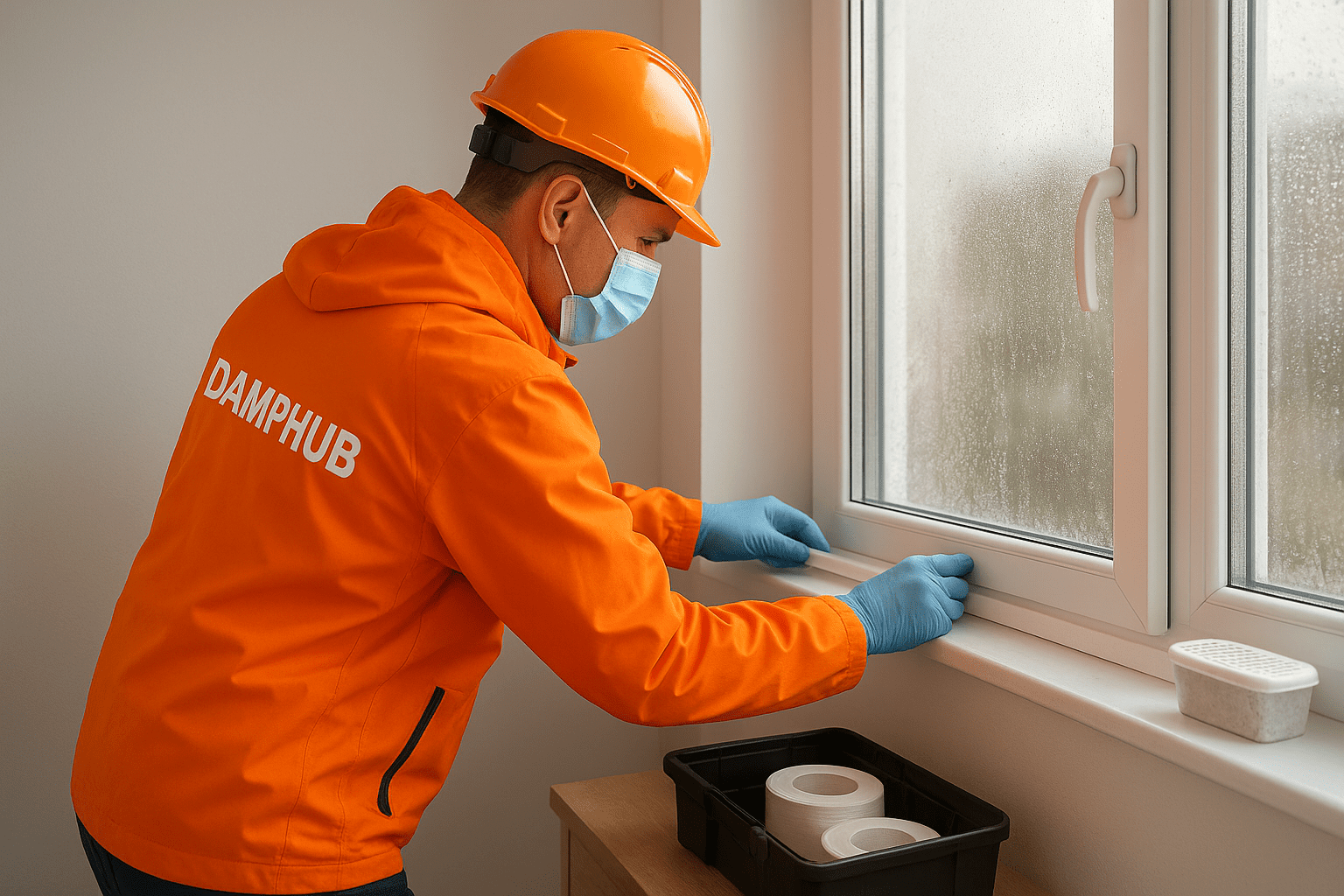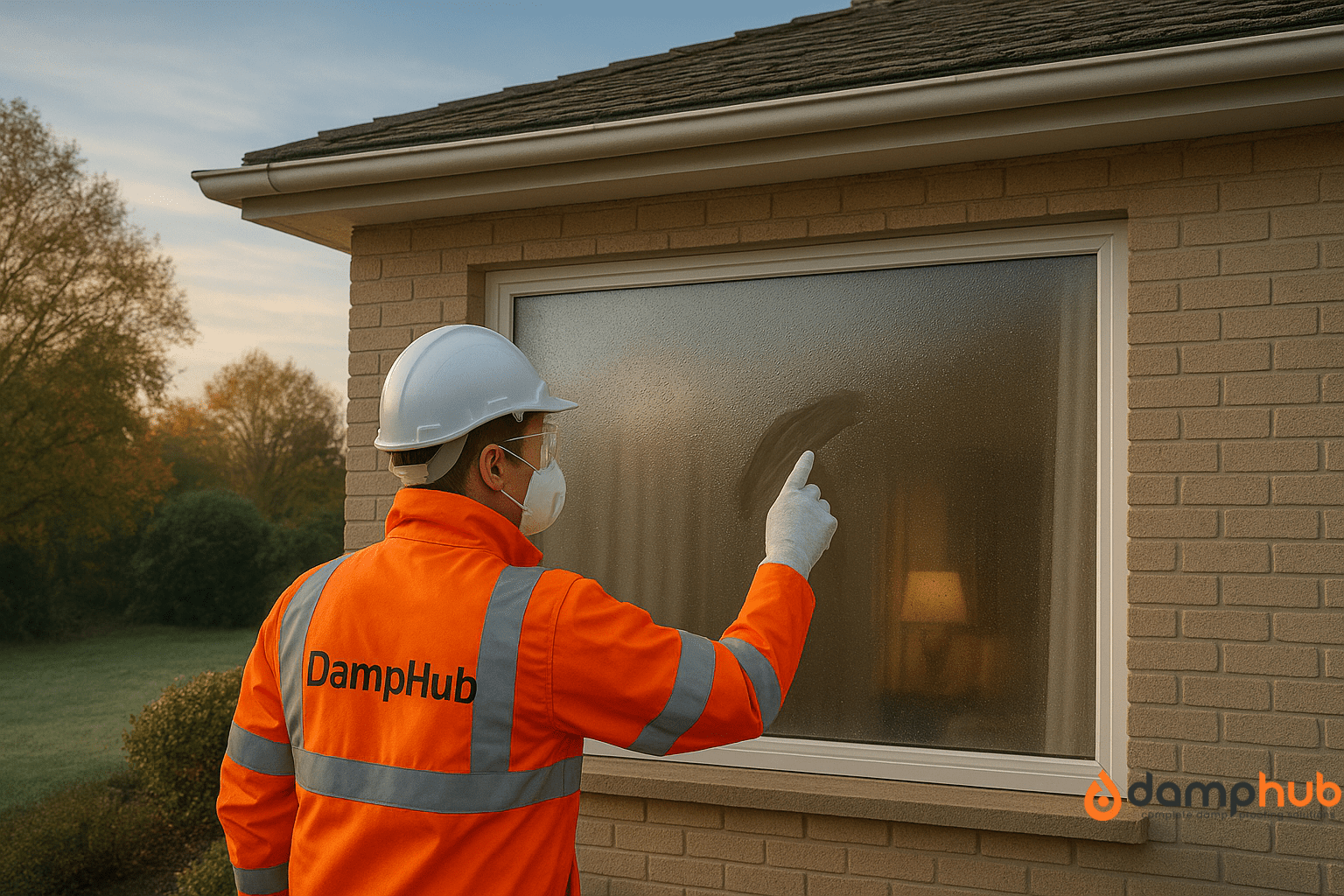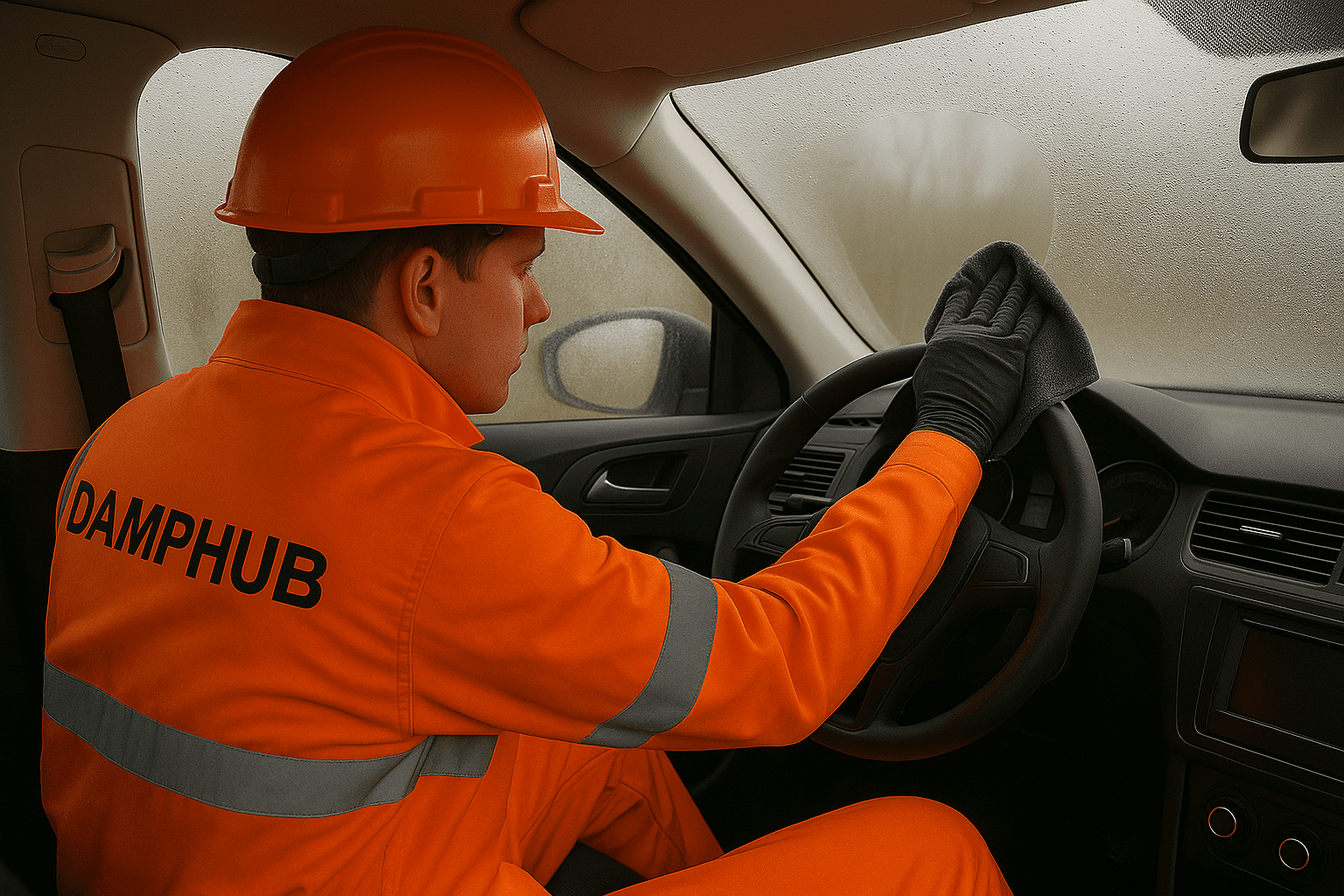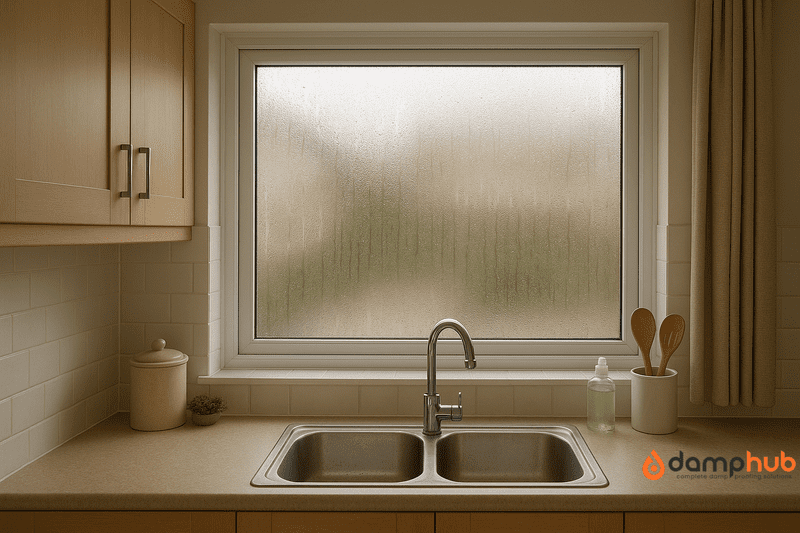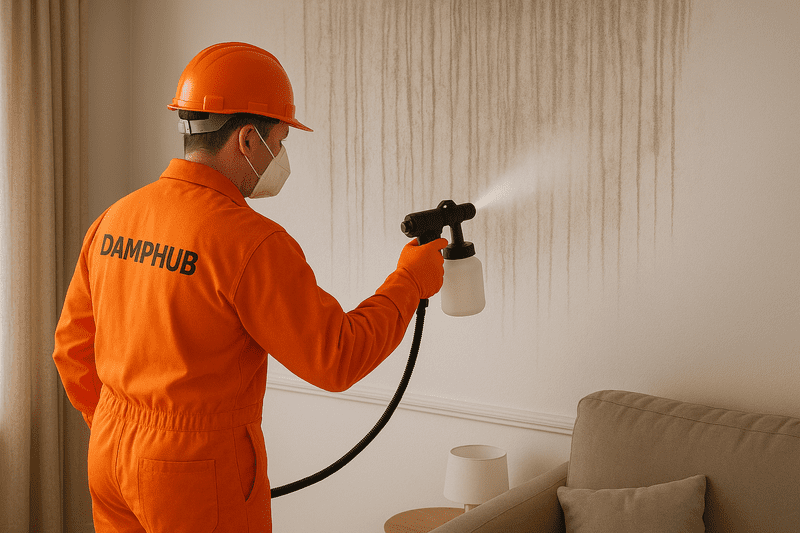
Are you of stubborn condensation, mould, and damp patches that keep coming back, no matter how often you scrub? Thermal insulation paint could be the simple, low-cost fix. Unlike standard emulsions, these specialist coatings contain microscopic insulating beads that keep walls and ceilings warmer, making it harder for moisture to cling to cold surfaces.
The result? Less condensation, fewer black mould outbreaks, and a healthier home overall. It’s convenient in problem spots like bathrooms, bedrooms, and north-facing walls — the places damp always seems to find.
If you’re not ready for expensive renovations or relying on dehumidifiers day and night, insulation paint offers an easy upgrade. To save you the guesswork, we’ve rounded up the 10 best thermal insulation paints available on Amazon UK, from everyday emulsions to specialist anti-mould and bathroom formulas. Each one has been chosen for its performance, value, and proven results.
Related post you may want to read: 10 Best Anti Condensation Paints in The UK
10 Best Thermal Insulation Paints for Condensation
Affiliate Disclosure: Some of the links in this guide are affiliate links, which means we may earn a small commission if you purchase through them — at no extra cost to you. We only recommend products we’ve tested, researched, or trust to help reduce condensation, mould, and damp in your home.
1. Dryzone Thermal Paint (1L, White, Matt Finish)
Best for: Homeowners who want a proven thermal paint to reduce condensation and mould on cold interior walls.
Dryzone Thermal Paint is formulated to keep walls warmer and reduce condensation. It contains advanced glass microspheres that improve insulation by lowering heat loss through the painted surface. Once applied, the wall feels warmer to the touch, which makes condensation less likely to form.
The paint also includes a preservative effect that discourages mould growth, while its open-pore structure allows moisture to disperse rather than sit on the surface. It applies with a standard brush or roller and dries to a smooth white matt finish that looks like a normal emulsion but works far harder against damp.

Key Features
- Glass microsphere technology that improves insulation.
- Warmer wall surfaces reduce condensation risk.
- Built-in preservative discourages mould growth.
- Breathable, moisture-buffering finish.
- White matt coating for interior walls and ceilings.
Pros
- Makes walls warmer and less prone to damp.
- Helps prevent mould and fungal growth.
- Applies like ordinary paint.
- Attractive matt finish.
Cons
- Covers fewer square metres per litre than standard emulsions.
- More expensive than basic interior paint.
Why We Recommend Dryzone Thermal Paint
It combines the look of standard emulsion with thermal insulation that helps stop condensation, making it one of the most effective paints for damp-prone areas.
👉 See the latest price and reviews on Amazon: Dryzone Thermal Paint
2. Thermilate InsOpaint Ultra Insulation Paint (5L, White, Matt Finish)
Best for: Homeowners looking for large-area coverage that combines condensation protection with genuine energy-saving benefits.
Where Dryzone Thermal Paint is ideal for smaller damp-prone rooms, Thermilate InsOpaint Ultra takes things a step further. Supplied in a large 5-litre tub, it’s geared towards full room or whole-house coverage.
The technology is similar (insulating microspheres that keep wall surfaces warmer), but InsOpaint is positioned more as an energy-saving solution than just condensation control. It works on both interior and exterior walls, making it one of the most versatile paints in this category.

Key Features
- Insulating microspheres reduce heat loss through walls.
- Energy-saving benefits help cut heating costs.
- Acrylic, water-based formula with low VOC levels.
- Interior and exterior use on walls and ceilings.
- Protects against mould and damp.
Pros
- Makes rooms feel noticeably warmer.
- Washable, durable finish.
- Suitable for large-scale coverage (5L tin).
- Eco-friendly formulation.
Cons
- Colour shades can vary slightly from expectation.
- Pricier than standard masonry or emulsion paints.
Why We Recommend Thermilate InsOpaint Ultra (5L)
It offers whole-room and even whole-house coverage, combining condensation protection with genuine energy-saving benefits — making it one of the most versatile thermal paints available.
👉 See the latest price and reviews on Amazon: Thermilate InsOpaint Ultra Insulation Paint
3. Rempro Thermal Paint (2.5L, White, Textured Finish)
Best for: Homeowners who want proven condensation control with reliable test results, without committing to a large 5L tin.
If Dryzone is perfect for tackling small rooms and Thermilate excels at large-scale coverage, Rempro offers a strong middle ground. Sold in a 2.5L tub, it’s designed for everyday use in homes where cold walls and condensation keep causing problems.
Like the others above, it uses glass microsphere technology to keep walls warmer, but here the focus is on measurable performance — independent tests show condensation takes 57% longer to form on Rempro-coated walls compared to standard paint. That makes it especially appealing for bedrooms, bathrooms, and other areas where damp tends to linger.

Key Features
- Glass microsphere technology creates a thermal barrier.
- Surfaces stay warmer and resist condensation longer.
- Proven to delay condensation by 57% vs. standard paint.
- Helps inhibit mould and fungal growth.
- Textured white finish, can be overpainted for smoothness.
Pros
- Walls feel warmer and more comfortable.
- Noticeably slows condensation build-up.
- Versatile use on walls, ceilings, and plasterwork.
- Good balance of coverage and price.
Cons
- Textured finish may not suit all décor styles.
- Requires two coats for best results.
Why We Recommend Rempro Thermal Paint
It delivers proven, measurable results against condensation while staying affordable, making it a reliable choice for bedrooms, bathrooms, and everyday problem walls.
👉 Check reviews and prices on Amazon: Rempro Thermal Paint
4. Suretherm Thermal Paint (1L, White, Matt Finish)
Best for: Anyone wanting professional-grade insulation in a manageable 1L tin, with proven performance against condensation and mould.
Suretherm is one of the strongest performers in this category, aimed at homeowners who want more than a basic anti-condensation coating. Independent testing shows it holds heat 113% longer than standard emulsion, which means walls stay noticeably warmer. That warmth stops condensation from forming, which in turn keeps mould at bay.
Unlike some alternatives that rely on absorbing moisture, Suretherm works by reflecting heat into the room, creating a real thermal barrier. It’s quick to apply, touch-dry within a couple of hours, and a popular pick with landlords, decorators, and DIY users dealing with cold, damp-prone walls.

Key Features
- Glass bubble technology creates a strong thermal barrier.
- Holds heat 113% longer than standard emulsion.
- Reflects warmth into the room.
- Helps prevent mould and damp odours.
- Matt white finish, can be painted over in other colours.
Pros
- Noticeably warmer wall surfaces.
- Strong test results for insulation.
- Quick drying and easy to apply.
- Flexible for DIY or professional use.
Cons
- Needs two coats for best results.
- Pricier than regular interior paint.
Why We Recommend Suretherm Thermal Paint
Its independently tested performance and strong heat-retention results make it a go-to option for anyone who wants professional-grade condensation and mould control in their home.
👉 Check reviews and prices on Amazon: Suretherm Thermal Paint
5. Wykamol Thermaldry Thermal Paint (2.5L, White, Matt Finish)
Best for: Kitchens, bathrooms, and utility rooms where steam and condensation are hardest to control.
Wykamol Thermaldry is designed for the areas of a home that deal with constant moisture — kitchens, bathrooms, and utility spaces. Unlike other thermal paints we highlighted above, Wykamol uses hollow glass bead technology to reflect heat into the room, making wall surfaces warmer and less likely to attract condensation.
Once dry, the coating is also water-repellent and antibacterial, helping to stop black mould before it can take hold. Easy to apply on plaster, brick, concrete, or even metal, it’s a specialist choice for cold exterior walls and damp-prone ceilings.
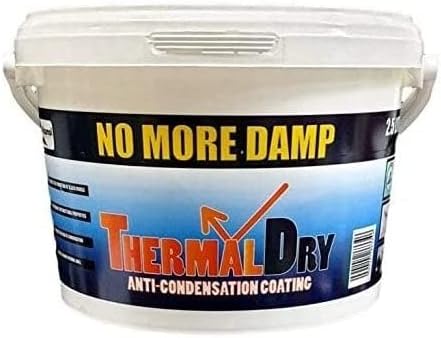
Key Features
- Hollow glass bead technology reflects heat.
- Reduces condensation by increasing wall temperature.
- Waterproof coating once dry.
- Antibacterial properties resist mould and fungi.
- Suitable for kitchens, bathrooms, and cold exterior walls.
Pros
- Effective on persistent condensation spots.
- Makes walls warmer to the touch.
- Easy to apply over multiple surfaces.
- Eco-friendly and long-lasting.
Cons
- Matte white finish may need overpainting for décor.
- Coverage per litre is lower than standard emulsions.
Why We Recommend Wykamol Thermaldry Thermal Paint
It’s specifically engineered for high-moisture spaces like kitchens and bathrooms, offering both waterproofing and antibacterial protection that standard thermal paints can’t match.
👉 Check reviews and prices on Amazon: Wykamol Thermaldry Thermal Paint
6. Thermilate InsOpaint Ultra Insulation Paint (1L, Creamy White, Matt Finish)
Best for: Homeowners who want the proven Thermilate insulation and condensation control in a small, convenient tin for single rooms, ceilings, or testing before committing to a larger tub.
The 1L Thermilate InsOpaint Ultra brings the same insulation and condensation control as the larger 5L tin we mentioned earlier, but in a compact size for smaller jobs. It’s ideal for single rooms, cold spots, or damp-prone areas where a full tub isn’t necessary.
Like the 5L version, it uses hollow microspheres to keep walls warmer, helping prevent condensation and mould. The creamy white matte finish works well with most décor, while the water-based acrylic formula keeps VOC levels low, making it safe for indoor use. This smaller tin is perfect for touch-ups or testing the product before committing to larger areas.

Key Features
- Hollow microspheres reflect heat and keep wall surfaces warmer.
- Reduces condensation and inhibits mould growth.
- Low-VOC, water-based acrylic formula safe for interiors.
- Suitable for interior walls and ceilings.
- Compact 1L tin for single-room coverage or touch-ups.
Pros
- Perfect size for small-scale or targeted projects.
- Makes walls warmer to the touch.
- Easy to apply with a roller or a brush.
- Offers all the energy-saving benefits of the 5L version.
Cons
- Creamy white may appear slightly darker than expected.
- Limited coverage; not ideal for whole-room applications.
Why We Recommend Thermilate InsOpaint Ultra (1L)
It gives you all the benefits of Thermilate’s proven insulation technology in a compact, affordable size that’s perfect for smaller projects or testing before a larger application.
👉 Check reviews and prices on Amazon: Thermilate InsOpaint Ultra Insulation Paint 1L
7. Thermilate Thermalmix – Insulating Paint Additive (200g, Clear)
Best for: Homeowners who already have a favourite paint but want to add insulation benefits.
Unlike ready-mixed thermal paints such as Dryzone or InsOpaint, Thermalmix is a clever additive that turns ordinary paint into insulating paint. You simply stir the 200g pack into 5 litres of your chosen paint, whether for walls, ceilings, or even exterior use.
The powder contains microspheres that act like tiny thermal barriers, helping rooms warm up faster and hold heat longer. Because you can add it to almost any paint, it offers more flexibility than pre-mixed tins and lets you keep your preferred colour scheme while still tackling condensation and mould.

Key Features
- Mixes with 5 litres of standard paint.
- Microsphere technology for thermal insulation.
- Works on walls, ceilings, and some exteriors.
- Helps reduce heating bills by up to 25%.
- Eco-friendly and safe to use.
Pros
- Flexible – works with most paint brands and colours.
- A cost-effective way to add insulation.
- It can be used indoors or outdoors.
- Helps limit mould and condensation.
Cons
- Coverage depends on the paint you mix it with.
- Some users find that it changes texture or is tricky to blend smoothly.
Why We Recommend Thermalmix Additive
It’s ideal if you want the benefits of insulation without switching to a specific branded paint. Thermalmix makes your usual paint smarter, adding protection against heat loss and condensation while keeping your colour choices open.
👉 Check reviews and price on Amazon: Thermilate Thermalmix
8. SIRAMIGUARD Thermal Insulation Paint
Best for: Homeowners who want a safe, eco-friendly paint that controls condensation on both walls and cladding.
SIRAMIGUARD Thermal Insulation Paint is designed for homeowners who want reliable thermal efficiency without complicated upgrades. Unlike standard emulsions, this paint is formulated to cut down heat loss, stop cold bridging, and tackle condensation problems in tricky spaces like cladding, containers, or internal walls.
Its water-based formula is low in VOCs, odour-free, and resistant to mould and fungal growth, making it a safe and practical choice for everyday use. Whether rolled, brushed, or sprayed, it offers a straightforward way to insulate surfaces while keeping interiors warmer and drier.

Key Features
- Thermal insulation coating with low conductivity.
- Prevents condensation build-up in varying temperatures.
- Water-based, non-toxic, and odour-blocking formula.
- Mould and fungal resistant for long-term protection.
- Versatile application: brush, roller, or airless spray.
Pros
- Straightforward to apply on walls and cladding.
- Reduces condensation issues effectively.
- Eco-friendly and safe for indoor use.
- Works on both interior and exterior surfaces.
Cons
- Requires a thicker coating for maximum results.
- Coverage is lower compared to standard paints.
Why We Recommend SIRAMIGUARD Thermal Insulation Paint
It’s a dependable option for insulating walls and cladding while keeping mould and condensation at bay.
👉 Check reviews and prices on Amazon: SIRAMIGUARD Thermal Insulation Paint
9. GoTherm Thermal Insulation Paint (2L, White, Matte Finish)
Best for: Homeowners and professionals who need a dual-purpose paint that works indoors and outdoors, especially on problem areas with thermal bridges.
GoTherm takes thermal paint a step further by bridging the gap between DIY-friendly solutions and professional-grade coatings. Unlike Thermalmix, which you stir into regular paint, or Thermilate InsOpaint, a ready-to-use emulsion, GoTherm doubles as both an interior and exterior system.
It’s specifically designed to tackle thermal bridges — those cold weak spots in walls that drive up heating costs and attract condensation. The water-based formula is low in VOCs, safe for residential and commercial buildings, and effective even in historic properties where bulky insulation isn’t an option.

Key Features
- Thin-layer thermal insulation coating for walls and surfaces.
- Targets thermal bridges to reduce heat loss and damp.
- Prevents condensation on walls with temperature differences.
- Water-based, eco-friendly formula with ultra-low VOCs.
- Suitable for homes, hospitals, historic buildings, and industry.
Pros
- Works indoors and outdoors with equal efficiency.
- Reduces condensation and mould in cold spots.
- Eco-friendly, odour-free, and low in VOCs.
- Effective even where traditional insulation can’t be installed.
Cons
- Leaves a slightly rough finish unless applied with plaster tools.
- Coverage is modest (1m² per litre at 1mm thickness).
Why We Recommend GoTherm Thermal Insulation Paint
It’s one of the most versatile paints in this category, tackling thermal bridges while being safe for everything from modern homes to listed buildings.
👉 Check reviews and prices on Amazon: GoTherm Thermal Insulation Paint
10. Prosidecon Projected Cork (12kg, Waterproof Thermal & Acoustic Insulation, Decorative Finish)
Best for: Homeowners, builders, and renovators who want a heavy-duty, all-in-one insulation and waterproofing solution that doubles as a decorative finish.
We’re closing this list with a real heavyweight — Prosidecon Projected Cork. Unlike the other paints and additives we’ve covered, this isn’t just about reducing condensation on walls. It’s a full-blown insulation and waterproofing system that handles thermal loss, noise reduction, moisture, and even salt damage in coastal areas.
Applied with a projection gun, it creates a breathable, joint-free coating that’s tough enough for facades, decks, roofs, and interiors. And because it’s cork-based, it’s 100% eco-friendly, non-toxic, and naturally resistant to mould, fungi, and bacteria.

Key Features
- Waterproof and breathable cork-based insulation.
- Provides both thermal and acoustic correction.
- Resistant to saltpetre — ideal for coastal homes.
- Decorative finish available in various colours and textures.
- Eco-friendly, non-toxic, and solvent-free.
Pros
- Heavy-duty performance for large projects.
- Combines insulation, waterproofing, and decoration in one.
- Natural resistance to mould, fungi, and salt damage.
- Cuts energy costs by up to 35%.
Cons
- Requires a projection gun for application (less DIY-friendly).
- Higher upfront cost compared to standard thermal paints.
Why We Recommend Prosidecon Projected Cork
It’s the ultimate way to finish this list — a professional-grade, eco-friendly system that does everything: insulates, waterproofs, decorates, and protects. If you want the most comprehensive solution available, this is it.
👉 Check reviews and prices on Amazon: Prosidecon Projected Cork, 12 kg
Comparison Table for the 10 Best Thermal Insulation Paints
10 Best Thermal Insulation Paints — Comparison Guide
| Product | Size / Finish | Best For | Extra Benefit |
|---|---|---|---|
| Dryzone Thermal Paint | 1L, White, Matt | Small damp-prone rooms | Glass microspheres improve insulation, warms walls, prevents mould |
| Thermilate InsOpaint Ultra | 5L, White, Matt | Large areas, whole rooms | Insulating microspheres, energy-saving, durable, washable |
| Rempro Thermal Paint | 2.5L, White, Textured | Medium rooms, measurable condensation control | Delays condensation 57%, slows condensation, versatile, good value |
| Suretherm Thermal Paint | 1L, White, Matt | Professional-grade insulation in small tin | Reflects heat, holds 113% longer, quick drying |
| Wykamol Thermaldry | 2.5L, White, Matt | Kitchens, bathrooms, utility rooms | Hollow glass beads, water-repellent, antibacterial |
| Thermilate InsOpaint Ultra | 1L, Creamy White, Matt | Small rooms, testing before large areas | Hollow microspheres, compact size, easy to apply |
| Thermilate Thermalmix | 200g, Clear Additive | Add insulation to existing paint | Converts normal paint into insulating paint, flexible, cost-effective |
| SIRAMIGUARD Thermal Paint | Varies, Water-based, Non-toxic | Safe, eco-friendly condensation control | Low conductivity, mould resistant, versatile application |
| GoTherm Thermal Paint | 2L, White, Matte | Indoor & outdoor problem areas | Targets thermal bridges, low VOC, effective on cold spots |
| Prosidecon Projected Cork | 12kg, Decorative Finish | Heavy-duty insulation & waterproofing | Cork-based thermal & acoustic insulation, multi-purpose, eco-friendly |
Buying Guide: Choosing the Right Thermal Insulation Paint
Thermal insulation paint isn’t just any wall paint — it actually works to keep walls warmer, reduce condensation, and protect against mould. To get the best results, there are several things you should think about before picking a product.
1. Job Size
How big is the area you need to cover? The size of your project matters because some paints come in small tins for touch-ups, while others are designed for large surfaces. Using the wrong size can waste money or leave you under-prepared.
- Small rooms or single walls: Dryzone or Rempro are ideal.
- Full-room coverage: Thermilate InsOpaint Ultra 5L saves time and effort.
- Large facades or commercial spaces: GoTherm and Prosidecon Projected Cork handle bigger projects efficiently.
2. Room Type and Moisture Levels
Different rooms face different moisture challenges. Bathrooms and kitchens get damp faster than bedrooms or living rooms, so choosing a paint suited to the environment is key.
- High-moisture spaces: Wykamol Thermaldry tackles condensation and steam.
- Living areas: Suretherm or Dryzone add warmth and control condensation without overdoing moisture protection.
3. Condensation vs Energy Savings
Some paints focus purely on stopping damp, while others also help save energy by improving insulation. Knowing what you need helps pick the right balance.
- Mainly anti-condensation: Dryzone, Rempro.
- Condensation control + energy efficiency: Thermilate InsOpaint Ultra reduces heat loss while keeping walls drier.
4. Interior or Exterior Use
Not all paints are built for outdoor conditions. Using interior-only paint outside can fail fast, while a dual-purpose option adds flexibility.
- Interior-only: small tins like 1L Thermilate InsOpaint Ultra.
- Interior & exterior: SIRAMIGUARD, GoTherm, Prosidecon Projected Cork.
5. Application Method
How a paint is applied affects how practical it is for your project. Some are simple roll-and-brush jobs, others need special tools.
- DIY-friendly: Dryzone, Rempro — easy with a roller or brush.
- Projection/spray applications: Prosidecon Projected Cork gives a decorative finish but needs a spray gun.
6. Coverage & Thickness
Thermal performance depends on coverage and layer thickness. Too thin, and it won’t insulate; too thick, and you’ll waste paint.
- Thin layers for minor insulation: small areas, touch-ups.
- Standard 1mm thickness for walls: GoTherm covers 1 m² per litre.
- Thicker or multiple layers for full insulation and damp protection: larger areas or historic walls.
7. Mould & Mildew Resistance
If your walls are prone to damp, look for paints that actively resist mould and mildew — it’s easier than scrubbing repeatedly later.
- High-moisture areas: Wykamol Thermaldry for kitchens and bathrooms.
- General interior & exterior protection: SIRAMIGUARD.
8. Eco-Friendliness & VOC Levels
Low-odour, eco-conscious paints are better for your health and the environment, especially in enclosed spaces.
- Low-VOC options: Thermilate InsOpaint Ultra, GoTherm.
- 100% non-toxic: Prosidecon Projected Cork.
9. Finish & Aesthetics
While thermal performance is key, the final look matters too. Some paints come in smooth matt finishes, others in textures or decorative finishes.
- Smooth walls: Dryzone, Thermilate InsOpaint Ultra.
- Decorative textures: Rempro (textured), Prosidecon (cork textures).
💡 Pro Tip
If you’re unsure which paint to pick, start by considering room type and moisture levels first — it usually dictates size, coverage, and whether you need anti-mould or decorative finishes. Then match it to your project size and desired energy efficiency for the best results.
Answering Your Questions on The Best Thermal Insulation Paints

-
Does thermal paint stop condensation?
Thermal paint doesn’t make condensation disappear completely, but it significantly reduces it by keeping wall surfaces warmer. Less cold surface = less moisture sticking, so black mould and damp are less likely to form.
-
How long does thermal paint last?
Most thermal paints last 5–10 years indoors if applied correctly. Longevity depends on the surface, moisture levels, and whether the area experiences heavy damp or steam.
-
How many coats of thermal paint do I need?
Usually, two coats are recommended for a full thermal effect. One coat might reduce condensation slightly, but two coats ensure proper insulation and coverage.
-
How to apply thermal paint?
– DIY-friendly paints: Use a standard roller or brush (Dryzone, Rempro).
– Specialist applications: Some paints like Prosidecon Projected Cork need a projection gun.Tip: Apply evenly, avoid leaving thin patches, and let each coat dry fully before the next.
-
Does thermal paint stop mould?
Thermal paint helps prevent mould by reducing condensation, but it’s not a disinfectant. For damp-prone areas, choose paints with built-in anti-mould properties like Wykamol Thermaldry or SIRAMIGUARD.
-
What are the disadvantages of thermal insulation paint?
– Coverage per litre is often lower than standard emulsions.
– It may leave a slightly textured finish unless carefully applied.
– High-end options can be more expensive upfront than regular paint.
– It won’t solve structural damp — underlying issues must be addressed first. -
What is a common mistake when applying thermal paint?
Applying too thin a layer or skipping the recommended number of coats. Uneven coverage can reduce insulation efficiency and condensation control.
-
Is there a wrong way to apply thermal paint?
Yes. Avoid:
– Applying on wet or unprepared surfaces.
– Using interior-only paint outdoors.
– Rushing between coats before the first one dries. -
Can you paint on top of thermal paint?
Yes, most thermal paints can be overpainted with standard emulsions, but check the manufacturer’s guidance. Smooth-textured finishes may need sanding or priming before topcoats for the best results.

